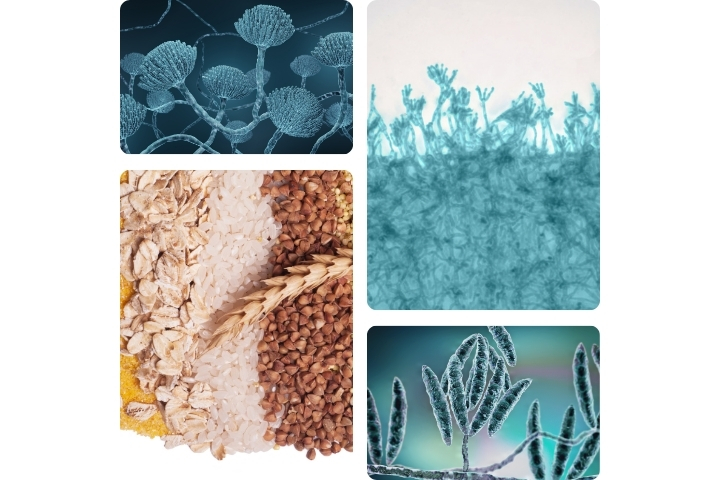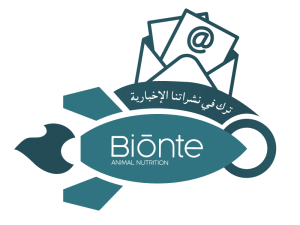Introduction
At present, the number of domestic animals has notoriously increased worldwide. Consequently, the strong demands for animal care and welfare are greater. The acquisition of nutritive food products and their quality carries a big responsibility for the food industry, constantly trying to maintain food safety and sanitation for both human and animal markets (Kepinska & Biel, 2021). Different microbiological risks can affect food quality, of which the following stand out bacteria, fungi and their toxins, the latter being a huge problem in animal and human health.
Mycotoxins contamination in pet food is a serious health threat to pets. Mycotoxins are harmful metabolites meanly produced by the three principal groups of fungi: Penicillium, Aspergillus and Fusarium.

The most representative mycotoxins are aflatoxins, ocratoxins, fumonisins, vomitoxins and zearalenone. As in the case of fodder, mycotoxins can be produced in cereals before, during and after harvesting at different environmental conditions. The pet food industry uses within its input cereals and cereal by-products in order to obtain digestible starch through an extrusion process. Despite this process offering high temperatures and pressures, mycotoxins cannot be completely inactivated. Hence, there is an enormous risk of contamination within the pet food industry (Grandi, et al., 2019) causing emotional and economic concerns for pet owners (Antonissen, et al., 2017). The European Commission has recommended allowable levels of mycotoxins which can be found within food (European Union, 2006). However, the risk of causing damage to the animal body is not completely eradicated since even continued exposure to low doses of certain mycotoxins might lead to severe adverse health (Kepinska & Biel, 2021).
Depending on the mycotoxin nature, the effects may be carcinogenic, teratogenic, immunosuppressant, mutagenic, hepatotoxic, neurotoxic or nephrotoxic. The following sections will show the effects of mycotoxins on both dogs and cats.

The effects of mycotoxins on dogs
Even though there are few reports about mycotoxins toxicity in domestic animals, it has been detected a great number of mycotoxins in their feeding stuff (Grandi, et al., 2019).
Aflatoxins
The dog is one of the domestic species more sensitive to intoxication by aflatoxins since they metabolize this mycotoxin inefficiently due to a low glutathione S-transferase activity, which has a key role in mycotoxin detoxification (Martinez, et al., 2021).
Clinical aflatoxicosis in dogs includes digestive, neural, hepatic, nephrotic and hemodynamic alterations. At the digestive level, vomiting, anorexia, hematemesis, hair and hematochezia can be developed. On the other hand, the nervous system is altered by the development of hepatic encephalopathy which is reflected in depression, seizures, stupor, vocalization and coma. Finally, in hemodynamics, the most frequent alterations are presented as ascites, dehydration, jaundice, peripheral edema and hemorrhages in mucous membranes. Most of the reported injuries are found in the liver and there are also registered abnormalities in coagulation (Martinez, et al., 2021). AFB1 contaminated food was described to be correlated with the development of hepatitis in dogs (Zain, et al., 2011). In female dogs, there is established an association between feed contamination with aflatoxins and the development of breast cancer (Frehse, et al., 2015).
Zearalenone
Dogs are considered a particularly sensitive species to zearalenone. These mycotoxins, which is produced by the fungi genera Fusarium, is structurally similar to natural estrogens. Thereby, zearalenone inclusion in food can cause considerable changes in the reproductive system (Kepinska & Biel, 2021). In female dogs, zearalenone can trigger oviduct and uterus edematization. In male dogs, the action of this mycotoxin is tightly connected to the reduction of spermatogenesis (Witaszak et.al, 2020). Therefore, considering zearalenone as an endocrine disruptor, it has been reported it can act at low doses as a promoter of breast cancer and other hormone-dependent tumors, especially in females (Ruiz-Suarez et al., 2015).
Trichothecenes
This group of mycotoxins, which are mainly produced by Fusarium species, are shown as small amphipathic molecules capable of passively moving through cellular membranes. They can be easily absorbed by the integumentary and gastrointestinal systems and, at the same time, they have a dynamic action of rapid proliferation within the tissues. The most highlighted toxins in this group are deoxynivalenol (DON), T2 and HT2. The most important and studied toxin is DON because its effects stand out in the public health system (Kepinska & Biel, 2021). In dogs, this group of mycotoxins may cause a loss of appetite and weight, vomiting, diarrhea and even gastrointestinal hemorrhage (Witaszak et.al, 2020).
Fumonisins
Fumonisins are a group of around 25 mycotoxins produced by the fungi genera Fusarium. The main fumonisins are FB1 and FB2 (Kepinska & Biel, 2021). These mycotoxins can disrupt the cellular sphingolipids metabolism and, in the same way, activate apoptotic, necrotic and cellular hyperplasia-related pathways. The information on the effects of fumonisins on dogs and cats is very limited. However, it is suggested that fumonisins inclusion in food can involve hepatotoxic and nephrotoxic risks (commonly found in acute intoxication), or they can cause immunosuppression (observed in cases of chronic intoxication) (Gazzotti, et al., 2015).
Ochratoxins
These mycotoxins are commonly produced by the fungi genera Aspergillus and Penicillium. As observed in other species, in this group of mycotoxins the target organ is the kidney. Dog intoxication by ochratoxins can present clinical symptoms such as anorexia, excessive thirst, polyuria, polydipsia, anxiety, prostration restlessness, weakness, and death (Zain, 2011).

The effects of mycotoxins on cats
Aflatoxins
In the bibliography, it was mentioned several cases of canine aflatoxicosis outbreaks. Conversely, it was no registered cases related to feline aflatoxicosis. Anyway, the detection of aflatoxins levels above the regulatory maximum content established for animal feeds represents a common reason to remove certain food, even if it occurs in cat foods.
Zearalenone
Zearalenone is described as a toxin that alters the reproductive hormonal function in animals by boosting the overexpression of estrogen receptors, ending up in similar problems as described above in dog’s situation. However, the information about the effects generated by zearalenone on cats is still limited (Knutsen, et al., 2017).
Trichothecenes
Cats are very sensitive animals to these group of mycotoxins, and it is highlighted the hematotoxicity induced by the T2 toxin (Glanemann et.al, 2023). Several studies found a huge amount of mycotoxins, especially T2 and HT2 in cereals and animal food. In 2021, it was reported that cat food containing high levels of T2 and HT2 mycotoxins caused severe pancytopenia causing several cat deaths (Glanemann, et al., 2023), and T2 injected into cats intravenously at 2 mg/kg resulted in hypovolemia and death (Devegowd, et al., 2000).
Fumonisins
As observed in dogs, there is a lack of reports about the health affection by this group of mycotoxins in cats (Witaszak et.al, 2020). However, it is worth noting that these toxins are toxic molecules frequently found within commodities and, in particular, they are stables in high temperatures. Hence, fumonisins represent an enormous relevance for pet food manufacturing companies (Grandi, et al., 2019).
Ochratoxins
In the same way, as in dogs, this toxin stands out for mainly affecting the kidneys of cats. Thus, ochratoxins alter the nephrotic structure and function triggering different clinical symptoms, such as polyuria, polydipsia and prostration (Zain, 2011).


Conclusion
The contamination with mycotoxins represents a huge challenge within the pet food industry since food processing fails to inactivate completely mycotoxin’s toxicity. Agreeing with the mentioned above, many contaminated products come to the market and can lead to acute or chronic intoxication of pets, according to doses and administration time of the toxin (Grandi et al., 2019). In accordance with the high relevance that mycotoxins present, the control strategy is addressed to the prevention of food contamination and the early detection of the toxic agent.



